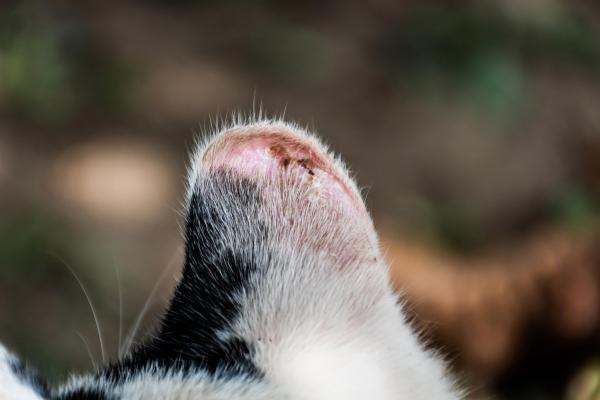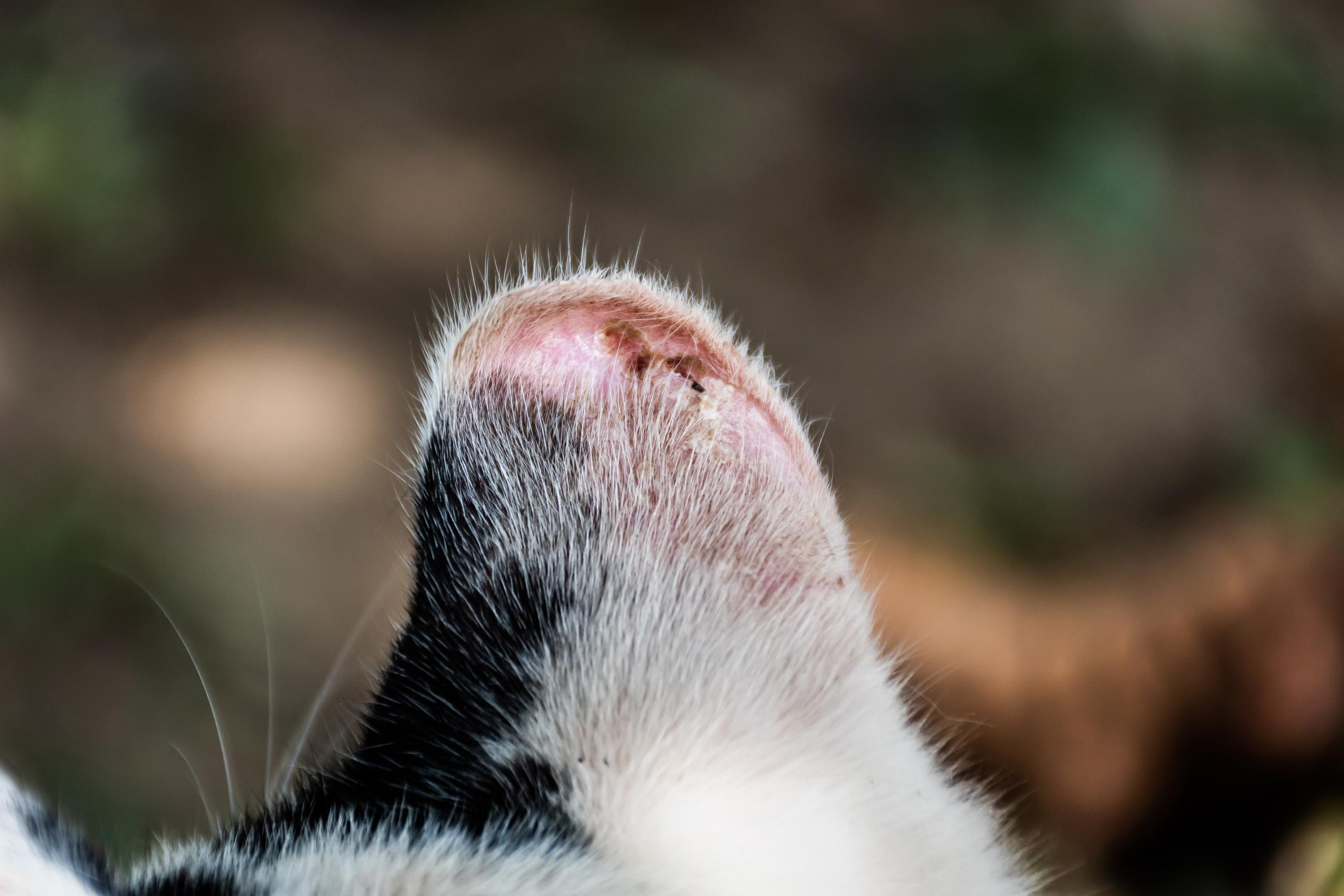Solar Dermatitis in Cats - Causes, Symptoms and Treatment



See files for Cats
Feline solar dermatitis is a pathology of the skin of our cats that arises as a result of frequent or continuous exposure to the sun. Also known as actinic dermatitis, it is especially prevalent in white cats and in those areas with less hair. The most affected area is the head, specifically the ears, eyes and lips. Ultraviolet rays from the sun are responsible for the skin inflammation by causing burns and injuries.
If you want to know more about solar dermatitis in cats, AnimalWised explains its causes, symptoms and treatment. We also explain which cats are most at risk and how you can best prevent the condition.
What is solar dermatitis in cats?
Also called actinic dermatitis, solar dermatitis is a skin condition that occurs as a result of continuous and frequent exposure to ultraviolet rays from the sun. The affected areas are usually those without pigment and with little hair density, such as the area above the eyelids, as well as the lips, nose, ears and paws. This is because these areas are most exposed to the sun, such as the area above the cat's eyes with often thinner hair.
Although we knows the cause of solar dermatitis in cats is sun exposure, the mechanism of action is not well understood. A possible mechanism of action of solar dermatitis in cats is the release of certain mediators after sun exposure. These mediators include serotonin, histamine, prostaglandins, free radicals and leukotrienes. Another possible mechanism is direct damage to the dermal vascular walls of cats.
It is more common in older cats with an average age of incidence being 10 to 11 years. It is especially those that live outside or spend long periods of time outside. It can also occur in cats of any age who like sunbathing on the balconies or windows of a home. Since hair protects the skin underneath, hairless cat breeds, those with naturally thin hair or those with patches of hair missing are at greater risk. White cats also have less sun protection.
Symptoms of solar dermatitis in cats
Feline solar dermatitis usually affects the cat's cephalic area, i.e. the head. Solar dermatitis in a cat ears is particularly common as they are often the most exposed. For this reason, we often first spot signs on the cat's ear. Since they are so exposed, they are also at greater risk of trauma from the cat scratching their ears to relieve itching or irritation.
The following are common signs of solar dermatitis in cats:
- Burns
- Flaky pr peeling skin
- Scabs
- Itching
- Pain
- Head shaking and scratching from itching and pain
- Spasmodic ear twitching
- Erythema or redness
- Thickening of the affected skin
- Mild bleeding or ulcers from self-trauma
- Alopecia or hair loss in the affected areas
- Squamous cell carcinoma in advanced cases
Solar dermatitis is not the only cause of squamous cell carcinoma. Learn more with our article on squamous cell carcinoma in cats.

Causes of solar dermatitis in cats
The main cause of solar dermatitis in cats is sun exposure due to the effect of ultraviolet radiation from the sun's rays on their skin. This is especially common in cats with little or not skin pigment. There are two diseases associated with the effects of this solar radiation, solar dermatitis and squamous cell carcinoma. The latter is sometimes a consequence of the former.
The vast majority of these two diseases (around 80%) develop in the cat's head area, as it is the most exposed and unprotected due to its lower hair density. It usually occurs in cats without pigmentation, i.e. white and albino cats. It can also appear in bicolor or tricolor cats that have white on their heads, or any cat if they have sufficient exposure to the sun.
Diagnosis of Solar Dermatitis in Cats
The first step in the diagnosis of feline solar dermatitis is to exclude other pathologies that can produce similar clinical signs and skin lesions. This requires going to a veterinarian who can carry out a differential diagnosis. To achieve a correct diagnosis, physical examination, medical history assessment and tests such as biopsy of the lesions need to be carried out. The main diseases with similar symptoms of solar dermatitis in cats include:
- Notoedric mange
- Allergic dermatitis
- Cutaneous autoimmune diseases
- Feline eosinophilic granuloma complex
- Trauma from fighting
Something that can clearly guide a diagnosis of solar dermatitis in cats is the presentation of the lesions in the depigmented areas. It is also important to know if they have a history of access to the outside or the habit of regularly sunbathing. Generally, cats with solar dermatitis have first degree burns in which only the superficial layer of skin is involved, which is red and without blisters. It is a relatively common disease in feral cats due to their lack of protection.
Solar dermatitis in cats treatment
The treatment will consist of controlling the lesions, avoiding their aggravation and preventing the appearance of new lesions. We do so by avoiding exposure to the sun's ultraviolet rays. Corticosteroids and antibiotics can be used to control the lesions. The cream used for topical treatment of solar dermatitis in cats must be prescribed by the veterinarian.
Among the corticosteroids which may be prescribed, the use of prednisolone at a dose of 1 mg/kg/day for 1 week and then every other day is effective as an anti-inflammatory. Synthetic retinoids can also be used to control dermatitis. Learn more with our related article on prednisone for cats.
In more advanced cases, radical surgery of the lesions may be necessary. Daily cleanings of burned areas and the use of intravenous fluids and even skin grafts may also be necessary. If a squamous cell carcinoma has developed, it will require surgical removal and the use of techniques such as cryosurgery.
For cleaning, you should use clean gauzes and saline solution. Be very careful to avoid hurting your cat or scaring them during their treatment. Keeping them calm and using positive reinforcement is essential.

Prevention of solar dermatitis in cats
Faced with a burn of this style, we do not recommend applying home remedies as treatment is specific. Follow the treatment stipulated by the veterinarian.
You should best ensure you provide suitable prevention for your cat. This is especially so if they are older, have little hair or have low skin pigmentation. Although cats like to lie in shafts of sunlight, we should reduce the amount of sun exposure, especially during the hottest hours of the day. It is also a good idea to apply cat sunscreen or use UV-blocking protection on your windows at home.
Learn about another danger of exposure to UV rays with our article on skin cancer in cats.
This article is purely informative. AnimalWised does not have the authority to prescribe any veterinary treatment or create a diagnosis. We invite you to take your pet to the veterinarian if they are suffering from any condition or pain.
If you want to read similar articles to Solar Dermatitis in Cats - Causes, Symptoms and Treatment, we recommend you visit our Skin problems category.
- Schaer, M. (2002). Clinical Medicine of the Dog and Cat. Editorial ELSEVIER.






